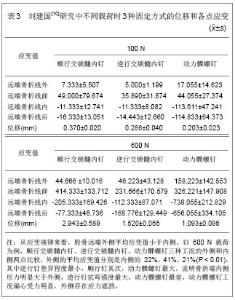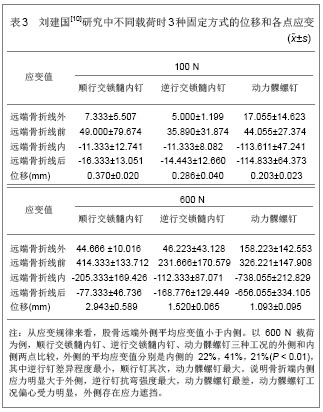| [1]Triffitt PD,Cieslak CA,Gregg PJA.quantitative study of the routes of blood flow to the tibial diaphysis after an osteotomy.J Orthop Res.1993;11(1):49-57.[2]李健民,胥少汀,邹德威,等.等髓内扩张自锁钉的结构特点及力学行为[J].中华骨科杂志,1998,18(12):728-732.[3]殷浩,端木群力,刘新功,等.交锁髓内钉取出术中常见并发症的预防与处理[J].美中国际创伤杂志,2005,16(2):44-45.[4]王雄,戴七一,李书振,等.扩髓与不扩髓条件下髓内钉置入内固定治疗成人股骨干骨折的系统评价[J].中国组织工程研究,2012, 16(26):4812-4816.[5]秦煜,Henry DeGroot III.极远端胫骨交锁髓内钉结合阻挡螺钉技术微创治疗胫骨远端骨折[J].中华创伤骨科杂志,2008,10(9): 835-537.[6]邓江,韩小松,王世强,等.交锁髓内钉远端瞄准器失准处理方法探讨[J].贵州医药,2002,26(4):334-335. [7]戚珊红.国产带瞄准器交锁髓内钉远端锁钉准确性研究[J].国际骨科学杂志,2007,28(4):268-269.[8]中国知网.中国学术期刊总库[DB/OL].2012-08-10. https://www.cnki.net[9]SCI数据库.Web of Sciencevia ISI Web of Knowledge[DB/OL]. 2012-08-10.http://ip-science.thomsonreuters.com/mjl[10]刘建国.股骨远端骨折交锁髓内钉和 DCS 内固定生物力学分析及临床意义[J].中国组织工程研究与临床康复,2010,14(48): 9104-9108.[11]陈梦东.医疗外科机器人集成系统研究[D].北京:北京航空航天大学,1998:1-10.[12]闫宏伟,龙泳,王坤正,等.新型髓内钉治疗股骨不稳定骨折的生物力学研究[J].第四军医大学学报,2006,27(19):1769-1772.[13]Hupel TM,Aksenov SA,Schemitsch EH.Muscle perfusion after intramedullary nailing of the canine tibia.J Trauma.1998; 45(2):256-262.[14]Uhlin B,Hammer R.Attempted unreamed nailing in tibial fractures: a prospective consecutive series of 55 patients.Acta Orthop Scand.1998;69(3):301-305.[15]Schemitsch EH,Kowalski MJ,Swiontkowski MF,et al. Comparison of the effect of reamed and unreamed locked intramedullary nailing on blood flow in the callus and strength of union following fracture of the sheep tibia.J Orthop Res. 1995;13(3):382-389.[16]Hutson JJ,Zych GA,Cole JD,et al.Mechanical failures of intramedullary tibial nails applied without reaming.Clin Orthop Relat Res.1995;13(315):129-137.[17]Seif el Nasr M,Münst P,Kuner EH.Management of tibial shaft fracture with an unreamed intramedullary nail. A principally changed implant.Fortschr Med.1995;113(9):123-126.[18]Rand N,Mosheiff R,Liebergall M.The role of intramedullary nailing in modern treatment of open fractures of the tibia and femur.Mil Med.1994;159(11):709-713.[19]Dervin GF.Skeletal fixation of grade IIIB tibial fractures. The potential of metaanalysis.n Orthop Relat Res.1996;(332): 10-15.[20]Lang GJ,Cohen BE,Bosse MJ,et al.Proximal third tibial shaft fractures. Should they be nailed?Clin Orthop Relat Res. 1995; (315):64-74.[21]Gregory P,Sanders R.The treatment of closed, unstable tibial shaft fractures with unreamed interlocking nails.Clin Orthop Relat Res.1995;(315):48-55.[22]安春宇,刘伟平,崔锡坤.股骨交锁髓内钉锁钉困难的原因分析[J].医学理论与实践,2007,20(2):186-187.[23]王志国.交锁髓内钉置入内固定治疗胫骨骨折的生物力学和影像学分析[J].中国组织工程研究与临床康复,2008,12(17): 3329-3332.[24]张超群.股骨带锁髓内钉治疗股骨干骨折的体会[J].中国社区医师(医学专业半月刊),2009,11(1):35.[25]Brumback RJ,Virkus WW.Intramedullary nailing of the femur: reamed versus nonreamed.J Am Acad Orthop Surg.2000;8(2): 83-90.[26]Buly RL,Huo MH,Salvati E,et al.Titanium wear debris in failed cemented total hip arthroplasty. An analysis of 71 cases.J Arthroplasty.1992;7(3):315-323.[27]Suhm N,Messmer P,Zuna I,et al.Fluoroscopic guidance versus surgical navigation for distal locking of intramedullary implants. A prospective, controlled clinical study. Injury.2004; 35(6):567-574.[28]刘文勇,王满宜,王田苗,等.计算机辅助髓内钉远端锁定系统误差分析[J].北京航空航天大学学报,2004,30(9):850-854.[29]王满宜,王军强,刘文勇,等.计算机辅助创伤骨科手术机械臂导航定位方法的研究[J].中华医学杂志,2006,86(9):609-613.[30]买买提艾力•尼亚孜,艾合买提•吾买尔.逆行髓内钉和钢板置入内固定治疗股骨远端骨折的比较[J].中国组织工程研究,2012, 16(44):8201-8205.[31]廖燚,白靖平,锡林宝勒日,等.扩髓与非扩髓髓内钉固定术治疗成人股骨干骨折的系统评价[J].中华骨科杂志,2006,26(6): 404-408.[32]严雪港,鲍同柱,赵卫东,等.股骨静力交锁髓内钉生物力学性能及对骨折愈合的影响[J].中国组织工程研究与临床康复,2010, 14(17): 3123-3126. |

